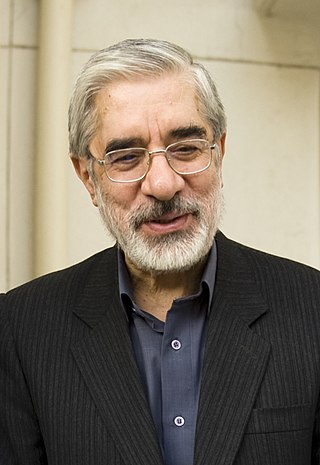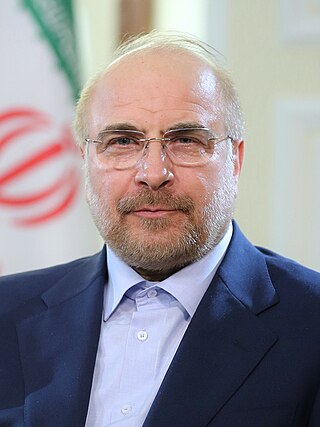
Seyyed Abolhassan Banisadr was an Iranian politician, writer, and political dissident. He was the first president of Iran after the 1979 Iranian Revolution abolished the monarchy, serving from February 1980 until his impeachment by parliament in June 1981. Prior to his presidency, he was the minister of foreign affairs in the interim government. He had resided for many years in France where he co-founded the National Council of Resistance of Iran.

Mir-Hossein Mousavi Khameneh is an Iranian reformist politician, artist and architect who served as the 49th and last Prime Minister of Iran from 1981 to 1989. He was a reformist candidate for the 2009 presidential election and eventually the leader of the opposition in the post-election unrest. Mousavi served as the president of the Iranian Academy of Arts until 2009, when conservative authorities removed him. Although Mousavi had always considered himself a reformist and believed in promoting change within the 1979 Revolution constitution, on 3 Feb 2023, in response to the violent suppression of Iranians by Ali Khamenei, the Supreme Leader of Iran, he announced opposition to the Islamic Republic constitution and asked for a widespread referendum to fully change the constitution and make a fundamental change in Iran's political system.

Mohammad Bagher Ghalibaf or Mohammad Baqer Qalibaf is an Iranian conservative politician, former military officer, and current Speaker of the Parliament of Iran since 2020. He held office as the Mayor of Tehran from 2005 to 2017. Ghalibaf was formerly Iran's Chief of police from 2000 to 2005 and commander of the Revolutionary Guards' Air Force from 1997 to 2000.
Presidential elections were held in Iran on 24 July 1981 after the previous Iranian president, Abolhassan Banisadr, was impeached by the Majlis on 21 June and then sacked by the Supreme Leader, Ayatollah Khomeini, on 22 June. The elections occurred after the Hafte Tir bombing, which killed Mohammad Beheshti and dozens of other Iranian officials on 28 June 1981. This led to the election of Mohammad Ali Rajai, the previous prime minister, winning 13,001,761 votes out of the 14,573,803 votes cast, which was 89% of the votes. The vote turnout was 65.29%.
Abdul Rahman Ghassemlou was an Iranian Kurdish politician and leader. Ghassemlou was the Secretary-General of the Democratic Party of Iranian Kurdistan (KDPI) from 1971 until his assassination in 1989 by individuals suspected of being agents of the Islamic Republic of Iran.

Mir-Hossein Mousavi Khameneh served as the last Prime Minister of Iran, from 1981 to 1989, before the position was abolished in the 1989 review of the Iranian constitution. In the years leading up to the Islamic Revolution, Mousavi and his wife, Zahra Rahnavard, moved to the United States; they returned to Iran shortly after the establishment of the Islamic Republic.

Government of Mohammad-Ali Rajai was the first government of Iran after the Iranian Revolution. At that time, Abolhassan Banisadr was president and Mohammad-Ali Rajai was prime minister.

Parliamentary elections were held in Iran on 13 March 1980, with a second round on 9 May. They were the first elections to the Majlis since the overthrow of the Shah, and were contested to a considerable degree on a party basis.

Presidential elections were held in Iran on 14 June 2013. Hassan Rouhani won with a landslide victory, elected in the first round of voting with 50.71% of the vote. Tehran Mayor Mohammad Bagher Ghalibaf finished second with 16.56% of the vote. Over 36.7 million Iranians voted, 72.71% of eligible voters.

Hassan Rouhani, a moderate Iranian politician and former Secretary of the Supreme National Security Council, also known as the Diplomat Sheikh, launched his presidential campaign in March 2013. He was earlier expected to withdraw and endorse Ali Akbar Hashemi Rafsanjani after he registered, but he returned to the race after Hashemi's disqualification. The symbol of Rouhani's campaign was a key and his slogan was "Government of Prudence and Hope." On 15 June, he was elected as the president with 18,613,329 votes.
The Iranian presidential election debates of 2013 was held from 31 May to 7 June. For the 2013 election, the IRIB has approved three televised debates with all candidates, different from last election's format which was person-by-person. For each question, one candidate was chosen randomly to give his response. Then, other candidates shared their ideas. The eight candidates have explained their cultural and political plans during debates. The debates were focused on such issues as the economy, foreign policy, and Iran’s comprehensive talks with the P5+1 group over the country’s nuclear energy program. More than 45,000,000 people world-wide watched the debates according to IRIB.

Parliamentary elections were held in Iran on 26 February 2016 to elect members of the Islamic Consultative Assembly for all seats in the 10th parliament in the Islamic Republic era and the 34th since the Persian Constitutional Revolution. A second round was held on 29 April 2016 for some constituencies where candidates failed to obtain the required minimum 25 percent of votes cast. The elected MPs served from 28 May 2016 to 27 May 2020.

Front of Followers of the Line of the Imam and the Leader, formerly known as Islamic Aligned Organizations is a Coalition of Iranian Principlist political groups. The group which consists of a wide range of traditional conservative parties, is active since administration of Mohammad Khatami, and is aligned with The Two Societies.
The Council for Coordinating the Reforms Front or the Reformist Front Coordination Council is the umbrella organization, coalition and council of main political groups within the Iranian reform movement. Since 2015, it is overseen by the Reformists' Supreme Council for Policy-making.
Front of Transformationalist Principlists is an Iranian principlist political group, consisting of Society of Devotees of the Islamic Revolution and Society of Pathseekers of the Islamic Revolution.
Office for the Cooperation of the People with the President was a political organization in Iran that was closely associated to then-President Abolhassan Banisadr.

Hassan Rouhani, the incumbent President of Iran, launched his reelection campaign for the Presidential office in February 2017. The election itself and related events received international media attention with many issues being raised. Rouhani achieved a decisive victory after the May 2017 vote, with Interior Minister Abdolreza Rahmani Fazli announcing that out of 41.3 million total votes cast Rouhani got 23.6 million. Ebrahim Raisi, Rouhani's closest rival, had picked up 15.8 million votes in contrast.
The 2017 Ebrahim Raisi presidential campaign began when Ebrahim Raisi, chairman of the Astan Quds Razavi, launched his campaign for the 2017 presidential election. Raisi's campaign pursued a populist agenda.

Presidential elections were held in Iran on 18 June 2021, the thirteenth since the establishment of the Islamic Republic in 1979. Ebrahim Raisi, the then Chief Justice of Iran, was declared the winner in a highly controversial election. The election began with the mass disqualification of popular candidates by the Guardian Council, and broke records of the lowest turnout in Iranian electoral history, as well as had the highest share of protest blank, invalid and lost votes despite a declaration by the Supreme Leader of Iran, Ali Khamenei, considering protest voting religiously forbidden (haraam) as it would "weaken the regime." Reporters Without Borders reported 42 cases of journalists being summoned or threatened for writing about candidates, and the chief of the police threatened people who discouraged others to vote.













